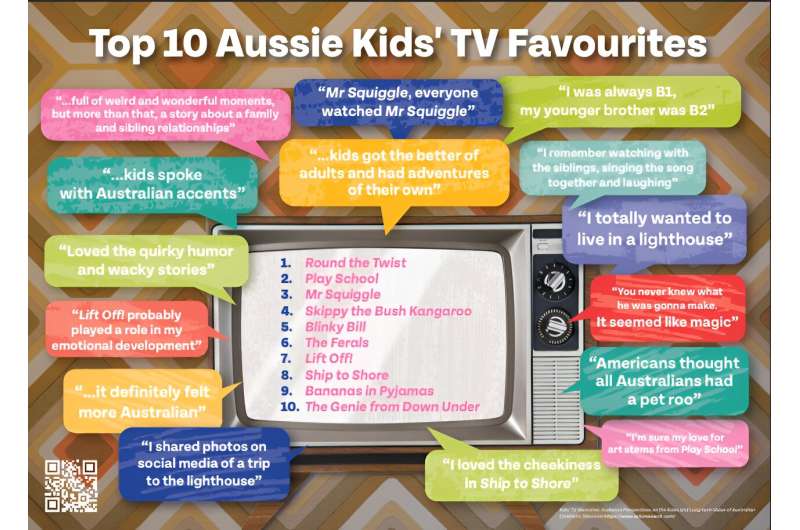This article has been reviewed according to Science X's editorial process and policies. Editors have highlighted the following attributes while ensuring the content's credibility:
fact-checked
trusted source
proofread
The cultural impacts of Australian kids' TV last for decades, says report

What has made Australian children's television distinctive over the decades? Why do adults use digital platforms to engage with shows from their childhood? In what ways does local children's television influence how the population understands what it means to be Australian?
A Swinburne University of Technology-based research team, Australian Children's Television Cultures, has completed a nationwide study to discover why and how adult audiences in the streaming era engage in nostalgic screen practices, and what impacts Australian children's television has had on multiple generations.
The study analyzed 542 survey responses and 21 extended interviews with adults who grew up watching television in Australia.
It addresses a range of issues, including the lasting impacts of local children's content on Australian cultural identity, why adult audiences revisit Australian children's television from the past, the influence of digital technologies on sharing old children's content, and the significance of Australian children's television to personal and collective memories.
"This study reveals just how significant Australian children's TV is to the cultural life of our nation," says Chief Investigator Dr. Joanna McIntyre. "It's provided lasting experiences of wonder and a continuing sense of belonging to generations of Australians for more than 60 years.
"This research also shows that although children watch TV differently in the streaming era, digital platforms actually offer new ways to share and connect via beloved Aussie children's content."
The report found that for nine out of 10 survey respondents, some of their favorite shows growing up were Australian.
It also identified that the most memorable Australian children's shows were 'cheeky' or 'edgy' and often included a particular formula—a mix of weird, quirky elements with depictions of relatable Australian life.
As one survey respondent (aged 25–30) said of the Australian shows she watched growing up: "They were all particularly quirky, scary, funny, and took you through the emotional roller coaster of being a kid (even though sometimes in a fictionalized setting). With all the quirkiness removed, it was relatable and just reflected an Australian childhood."
Demonstrating the popularity of using digital platforms to access shows from the past, seven out of 10 survey respondents have revisited Australian children's content from childhood in recent years. The most common means used being online clips, streaming services and social media. Respondents identified nostalgia as the top reason for revisiting children's shows from the past. Other key reasons included sharing shows with their own children and general curiosity.
Interviewee Chris (25) said, "I really feel like so much of my understanding of Australia and Australian culture, especially at an early age, was very much informed by Australian children's shows."
The study revealed sharing older Australian children's content has social bonding roles. Two out of three respondents have shared Australian children's content in recent years: 58 percent have shared with family members to give younger relatives insight into their own childhood or to reminisce with relatives of a similar age. Furthermore, 52 percent have shared with friends and colleagues to remember old favorites or introduce others (especially younger people) to certain shows.
Highlighting that Australian children's shows are seen to represent something essentially 'Aussie', almost a third of respondents have shared Australian children's shows with friends and family who did not grow up in Australia to showcase Australian content, interests, and values.
As interviewee Matt (38) said, "Showing Australian children's shows to other people from other countries is a source of pride as much as a, 'Here's a way to help you understand Australia and its unique culture'… It's just good texture to understand Australia."
This research is supported by the Australian Children's Television Foundation (ACTF), the national children's media production and policy hub which supports much-loved shows including Crazy Fun Park, Round the Twist, and Dance Academy.
"This research demonstrates how what we watch when we're young has a profound impact, shaping our experience of Australian culture and connecting us with our community and peers," ACTF CEO Jenny Buckland says.
"This is why it's so important to support Australian children's content via measures like regulation and public investment. Those wonderful shows people are remembering from the 1990s and 2000s were all supported by public policies. We need to make sure children today have the same opportunities to grow up with Australian shows."
The findings have been published in a comprehensive new report, "Kids' TV Memories: Audience Perspectives on the Roles and Long-Term Value of Australian Children's Television."
More information: Joanna McIntyre et al, Kids' TV Memories: Audience Perspectives on the Roles and Long-term Value of Australian Children's Television, Swinburne University of Technology (2023). DOI: 10.26185/cchb-wf43
Provided by Swinburne University of Technology




















